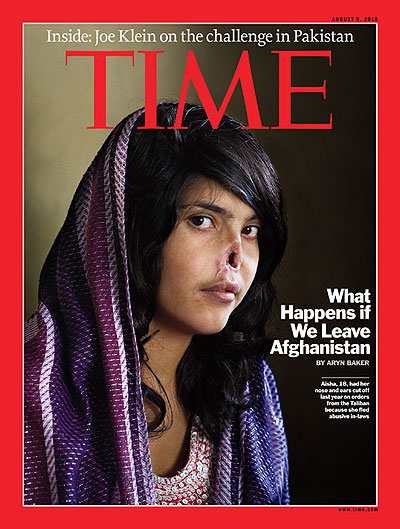By Beth Capper
“What Happens if We Leave Afghanistan?” asked the cover of the August 9 issue of Time Magazine. Time answered its own question on the very same page: for next to this query was a disturbing photograph of an 18-year old Afghan woman named Bibi Aisha, whose nose and ears were cut off on the Taliban’s orders for attempting to escape her abusive household.
Time Magazine is not the first to use women’s rights as a bargaining chip in wars waged on behalf of the U.S. in the Middle East. In 2004, George Bush proclaimed the success of the U.S. invasion of Afghanistan for women, stating, “Three years ago, women were viciously oppressed and forbidden to work outside the home, and even denied what little medical treatment was available. Today, women are going to school, and their rights are protected in Afghanistan’s constitution.” Similar arguments have been made on behalf of the women of Iraq, and as a condemnation of Ayatollah Khomeini’s Islamic dictatorship in Iran, perhaps to prepare the public for another war waged “on behalf of women’s rights.”
Such claims by the U.S. government, however, amount to little more than grandstanding. If women’s rights really are an issue, the U.S. might begin by discontinuing its generous support of Saudi Arabia, a country with a deplorable record of human rights abuse against women and where the female population is still unable to vote. Indeed, as noted by Huda Juwad, writing for Dissident Voice, “The United States has no qualms about supporting Saudi Arabia with billions of dollars in military sales and various ‘aid’ packages each year — in addition to whiskey and other unmentionables — in order to maintain the status quo that currently operates [in] the Middle East for American interests.”
In fact, contrary to George W.’s claims, many commentators suggest that the U.S. presence in Afghanistan has worsened the lives of Afghan women. The Revolutionary Association of the Women of Afghanistan (R.A.W.A.) has reported that, in many regions, violence against women has increased.
Kavita N. Ramdas, president and C.E.O of the Global Fund for Women, discussed war and women’s abuses in the Huffington Post, describing an initiative supported by the U.S government in the Democratic Republic of Congo that tripled the number of soldiers in the army to 60,000. “Rapes of women tripled in the areas the soldiers were deployed. There is an obvious connection between violence against women and militarization,” she argued. The consensus among many advocates for women working in Afghanistan is that women’s rights are as minimal now as they were prior to the occupation, and additionally women now have to contend with living in a war zone, as well as the threat of sexual and physical abuse from foreign soldiers.
Moreover, supporting the Karzai government in Afghanistan is seen as tantamount to supporting the continued oppression of women. Juwad argues that “in addition to open negotiations and concessions with the Taliban, Karzai is also gaining concessions from Hezb-i-Islami (Islamic Party) led by Gulbuddin Hekmatya [sic] – a faction whose attitude towards women rivals that of the Taliban in cruelty and oppression. There is another myth being promoted by the Afghan and US policy makers that some form of moderate Taliban exists; in reality, it is the same group of terrorists responsible for making life an utter hell for millions of Afghan women, but with more power and money.”
Just like feminist activists in the U.S., Afghan women’s groups, and their U.S. feminist supporters, seem divided about U.S. military occupation, although without talking to Afghan feminist groups working on the ground, it’s impossible to know. In the media, arguments for and against continued occupation are being made most visibly between the Feminist Majority and Women For Afghan Women on one side, and the R.A.W.A. on the other. In an article for the Huffington Post from 2009, Eleanor Smeal, spokeswoman for the Feminist Majority, laid out the group’s argument for the continued occupation of Afghanistan. She cited fears that the country would fall under Taliban control, as well as concerns that 40 percent of the country is still inaccessible to humanitarian aid workers. Without the presence of troops in addition to humanitarian aid, the group believes that many women will suffer dire consequences.
On the other side, R.A.W.A.’s stance is clear: they oppose the continued occupation of Afghanistan, U.S. involvement
in forming a new government, and especially U.S. support of the new Karzai regime. In addition, they oppose any negotiation with fundamentalists and feel that the fight for women’s rights in Afghanistan must be fought by Afghan radicals and progressives — a position similarly expressed by Iranian women activists. While being outspoken about the abuses against women perpetrated by Ahmadinejad and supporters of the Islamic Revolution, most Iranian women activists also oppose any U.S. involvement in women’s liberation initiatives.
R.A.W.A. has received widespread support from the U.S anti-war movement and radical feminist movements. However, in an article from 2003 for the American Prospect, writer Noy Thrupkaew argued that R.A.W.A. has also been criticized by some Afghan and Afghan-American women activists for ostracizing Afghan women’s NGOs and encouraging fighting instead of coalition-building. R.A.W.A. responded to Thrupkaew’s claims, stating that the NGOs in question were themselves aligned with or not critical enough of fundamentalism. Part of this response, published on equityfeminism.com stated: “Certainly, we have great respect towards those NGOs which are working for all people and not for any particular ethnic group, honestly, without any bias or tie with the fundamentalists and away from the widespread corruption, which unfortunately has befell many Afghan NGOs [sic].” Such issues are important to pay attention to as a means of understanding the nuances of Afghan feminist positions. However, it is important to take a non-judgmental stance. Women fighting in Afghanistan for their rights have to contend with struggles we can’t even imagine. Understand the intricacies but remain supportive of multifarious positions.
Ultimately, how the U.S. leaves Afghanistan is a complex issue. In moving beyond the reasons for beginning this war to the most appropriate way of ending it, we must remain critical, and keep our eyes and ears open to the demands, positions and differing opinions of Afghan feminist activists.






















